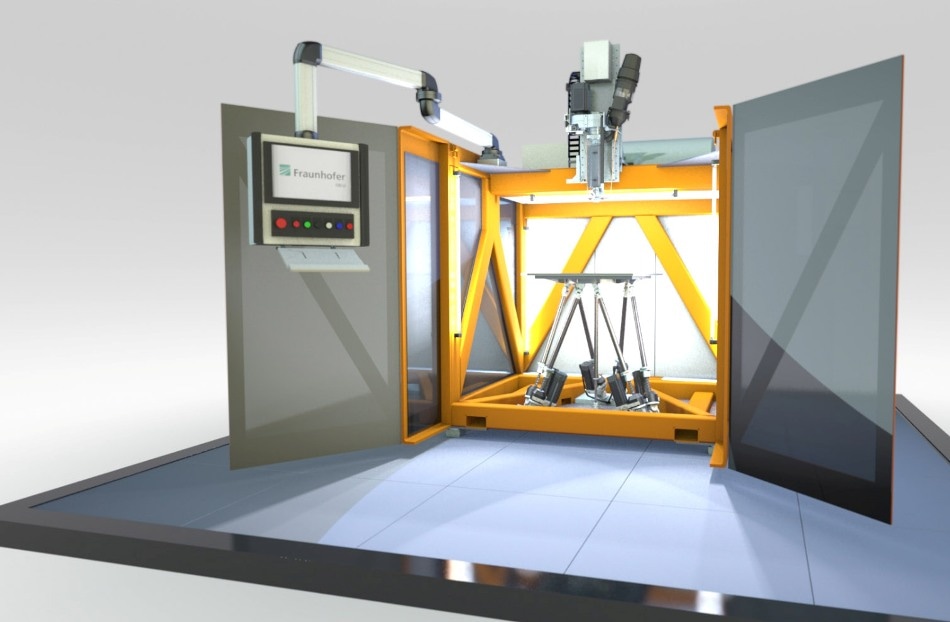Mar 4 2019
The additive manufacture of high-volume plastic components is a laborious task. Scientists at the Fraunhofer Institute for Machine Tools and Forming Technology IWU have currently designed Screw Extrusion Additive Manufacturing (SEAM), a system and process that is eight times faster than the standard 3D printing. Visitors to the Hannover Messe will be able to witness the ultrafast 3D printer in action at the Fraunhofer Booth C22 in Hall 2 between April 1st and 5th, 2019.
 SEAM can accelerate the additive manufacture of plastic components eightfold over conventional processes. The process achieves this ultra-fast production speed by combining 3D printing with the motion system of a machine tool. (© Fraunhofer IWU)
SEAM can accelerate the additive manufacture of plastic components eightfold over conventional processes. The process achieves this ultra-fast production speed by combining 3D printing with the motion system of a machine tool. (© Fraunhofer IWU)
3D printers capable of building small souvenirs layer by layer from melted plastic are frequently seen at tradeshows. A pocket-sized souvenir would require about an hour to be made. This process is extremely slow for the large-scale production of components, as needed by the automotive sector, for example.
A system from the Fraunhofer Institute for Machine Tools and Forming Technology IWU in Chemnitz is presently pushing 3D printing to a new level: The high-speed technology of the new system takes merely 18 minutes to make a plastic part that is 30 cm high. A team of scientists at the Fraunhofer IWU have created this technology for the additive manufacture of large-volume resilient plastic parts. Tool manufacturers along with the aerospace and automotive industries gain from the ground-breaking 3D printer that realizes eight times the process speed. This printer applies the SEAM process put together at the Chemnitz Institute.
How are high-process speeds possible with SEAM? “By combining machine tool technology with 3D printing,” says Dr. Martin Kausch, a scientist at Fraunhofer IWU. To process the plastic, the scientists use a particularly engineered unit that melts the raw material and ejects it at a high output rate. This unit is set up above a construction platform that can be rotated in six axes by using the motion system of a machine tool. “So far, this combination is unique,” says Dr. Kausch. The hot plastic is placed in layers on the construction platform. The motion system of the machine guarantees that the construction panel slides along under the nozzle in such a manner that the pre-programmed component shape is created. The table can be spun at a speed of 1m/second in the X-, Y- and Z-axes and can also be tilted by up to 45°. “This enables us to print eight times faster than conventional processes, enormously reducing the production times for plastic components.”
The 3D printer processes cost-effective basic material
Every hour, up to 7 kg of plastic are pressed through the hot nozzle with a diameter of 1mm millimeter. Similar 3D printing processes, such as Fused Filament Modeling (FLM) or Fused Deposition Modeling (FDM), typically realize only 50 g of plastic per hour. An exceptional feature is that, rather than high-priced FLM filament, SEAM processes free-flowing, economical standard plastic granulates into strong, fiber-reinforced parts that are several meters in size. This technique allows material costs to be lowered by a factor of two hundred.
SEAM allows scientists to execute multifaceted geometries without supporting structures. The best part is that the new system even makes it feasible to print on current injection-molded components.
As our construction platform can be swiveled, we are able to print on curved structures with a separately moving Z-axis. In tests, we were able to process a wide variety of plastics. They ranged from thermoplastic elastomers to high-performance plastics with a 50 percent content of carbon fiber. These plastics are materials that are particularly relevant to industry and cannot be processed with traditional 3D printers.
Dr. Martin Kausch, Scientist, Fraunhofer IWU.
The world’s first printer of its kind will be showcased for the first time at the Hannover Messe 2019.